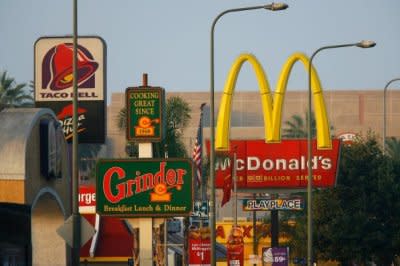What would you think about a ban on new fast food restaurants in your neighborhood?

Last month the Los Angeles City Council approved a policy that keeps new fast food restaurants from opening their doors in South L.A., a lower-income portion of the city where healthy eating options are difficult to find.
The Council passed a temporary ban in 2008, which the recent decision builds upon. Established fast-food restaurants will not close but new ones will be kept from opening. However, "fast-food casual" restaurants without drive-through windows, such as Denny's and Subway, will not be effected.
If you think this isn't the government's business you're not alone, but here's what complicates the situation (Quotes and statistics from The New York Times' related story):
1. There are already about 1,000 fast food restaurants in the 30 square-mile area in question, according to the City Council.
2.Obesity rates in the area are double that of more affluent parts of the city, and residents over 65 are much more likely to be diabetic or have heart disease.
3. "If people don't have better choices or don't have the time or knowledge or curiosity, they are going to take what's there," says Councilwoman Jan Perry.
4. Councilman Bernard Parks explains that they utilized land-use laws to limit fast-food restaurants the same way other communities do with bars or liquor stores.
Other communities block fast-food establishments just for aesthetic purposes. What's controversial about this case is that instead of residents lobbying the government for these restrictions, the local government appears to be fueling the fight. But the Associated Press reported that Councilwoman Perry found at community meetings that this is what community members want. "Residents are tired of fast food, and many don't have cars to drive to places with other choices," she said.
Something else to consider is that residents of low-income areas, by definition, have limited resources, not only in terms of transportation, but time. Multiple jobs and extra hours spent on the bus leave little time for people to advocate on behalf of their communities.
The moratorium on new fast food restaurants is intended to be an opportunity to draw healthier restaurants into the area. The question is whether a new salad spot can lure customers who feel at home under the double arches. "Research has shown that people will change eating habits when different foods are offered, but cost is a key factor in poor communities," said Kelly D. Brownell, director of Yale University's Rudd Center for Food Policy and Obesity in a related story by theAssociated Press.
Ultimately, the 1,000 fast food businesses already in the area ensure that the ban against new fast food locations will not limit residents' access. However, this new policy will send a message to fast-food corporations to stop relying so heavily on low-income communities to expand their fortunes.
What do you think about this complicated issue?
If an affordable healthy restaurant opened next to your local BK, would you eat fewer burgers?
For more:
The worst fast-food products of 2010
The best and worst fast-food salads
10 fast-foods turned into fancy dishes
